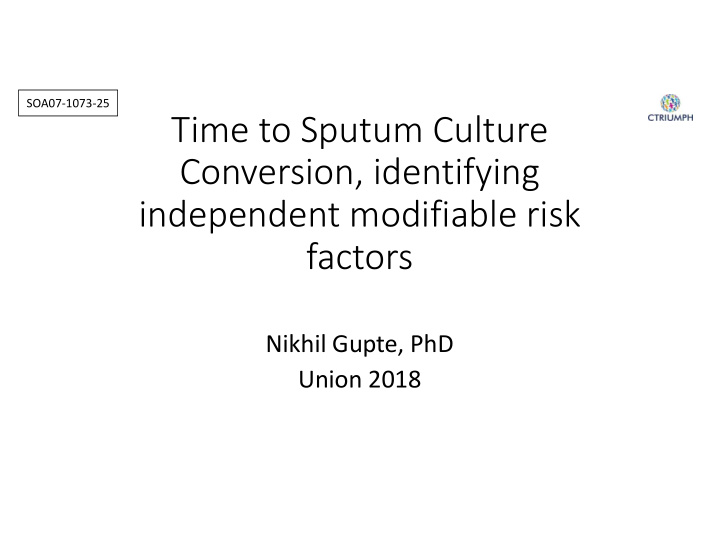



SOA07-1073-25 Time to Sputum Culture Conversion, identifying independent modifiable risk factors Nikhil Gupte, PhD Union 2018
Background and Rationale • Time to sputum culture conversion is widely used surrogate marker in early phase clinical trials • Delayed sputum culture conversion may be associated with poor TB treatment outcome • Time to sputum culture conversion, associated risk factors among drug sensitive pulmonary tuberculosis (PTB) have not been adequately documented • Clinical, socio-demographic and phyco-social characteristics that may influence time to sputum culture conversion may be helpful • Characterizing factors associated with delayed time to sputum culture may help targeting risk groups to optimize favourable TB treatment outcome.
Methods • 330 Adults (≥ 18 years), drug sensitive PTB patients from Pune and Chennai – CTRIUMPh Study sites • Sputum culture on Lowenstein-Jensen medium was done at entry, and weeks: 2, 4, 8, 16, 24 and 72. • Socio-demographic, behavioural and clinical data was collected at baseline and follow-up visits using structured case report forms • Time (in days) to first negative sputum culture, from AKT start date, was calculated • Kaplan-Meier product limit estimator was used to estimate the time to sputum culture conversion • Cox Proportional hazards models were used to identify independent and overlapping risk factors
Selected baseline characteristics & K-M Curve Baseline N Baseline N Time to LJ Sputum Culture Negative n = 330 n = 330 Characteristics Characteristics 1.00 Age Group AUDIT < 25 71 (22%) < 8 209 (63%) Proportion Culture Positive 25 – 40 109 (33%) > 8 121 (37%) 0.75 40 – 50 80 (24%) DM No DM 108 (37%) > 50 70 (21%) Gender Pre DM 73 (25%) Male 222 (67%) DM 110 (38%) 0.50 Female 108 (33%) Smear Baseline BMI Negative 87 (27%) Normal 109 (34%) Positive 240 (73%) 0.25 Underweight 198 (61%) Cavitation Overweight 18 (6%) No 144 (52%) Residence Yes 133 (48%) Rural 176 (53%) HIV 0.00 Urban 154 (47%) Uninfected 319 (97%) Smoking Infected 11 (3%) 0 50 100 150 200 Follow-up time (Days) Never 189 (62%) TB Treatment Number at risk Current 47 (15%) Daily 1 (0.3) 330 135 33 24 0 Former 71 (23%) Thrice Weekly 328 (99.7%) Smokeless tobacco Time to culture conversion No 85 (26%) Yes 238 (74%) Median (IQR): 35 (32 – 43)
Exploratory & Univariable Analysis Baseline Median ꝉ log-rank p- uHR (95% CI) p-value Baseline Median ꝉ log-rank p- uHR (95% CI) p-value (IQR) value Characteristics (IQR) value Characteristics Smoking Age Group Never 32 (16 – 62) < 0.001 Ref Ref < 25 29 (16 – 57) 0.004 Ref Current 55 (31 – 64) 0.63 (0.45 – 0.89) 0.01 25 – 40 33 (24 – 63) 0.68 (0.50 – 0.93) 0.02 Former 62 (68 – 31) 0.58 (0.43 – 0.77) < 0.001 40 – 50 36 (29 – 65) 0.62 (0.44 – 0.87) 0.01 Smokeless tobacco > 50 58 (30 – 64) 0.57 (0.40 – 0.80) 0.001 No 31 (16 – 59) 0.04 Ref - Gender Yes 46 (29 – 64) 1.30 (1.00 – 1.68) 0.05 Male 39 (29 – 64) 0.002 Ref - AUDIT Female 31 (16 – 62) 1.44 (1.13 – 1.83) 0.003 < 8 21 (17 – 62) < 0.001 Ref - BMI > 8 58 (31 – 71) 0.57 (0.45 – 0.73) < 0.001 Normal 34 (21 – 64) 0.05 Ref - DM Underweight 37 (27 – 64) 0.88 (0.69 – 1.13) 0.32 No DM 31 (17 – 58) 0.04 Ref - Overweight 31 (17 – 60) 1.56 (0.94 – 2.59) 0.08 Pre DM 35 (16 – 64) 0.73 (0.53 – 1.01) 0.06 DM 39 (29 – 64) 0.72 (0.55 – 0.96) 0.02 Residence Smear Baseline Rural 61 (32 – 65) < 0.001 Ref - Negative 29 (16 – 39) < 0.001 Ref - Urban 27 (15 – 51) 1.85 (1.47 – 2.33) < 0.001 Positive 55 (29 – 64) 0.53 (0.41 – 0.68) < 0.001 Anaemia Cavitation No 32 (21 – 60) 0.001 Ref - No 32 (21 – 62) 0.03 Ref - Yes 42 (27 – 64) 0.66 (0.51 – 0.85) 0.002 Yes 51 (30 – 64) 0.77 (0.60 – 0.98) 0.04 Findings: Older age, Males, Rural residence, Anaemia, Smoker, Alcohol dependence, Diabetes, AFB Positive & Cavitation were at an increased risk of delayed sputum culture conversion
Al Alcoho hol us use di disorde der, ana naemia & smear r po positi tivity ty are in indep epen enden ently ly as assoc ocia iated ed wit ith hig igh ris isk of of dela elayed ed cult lture e co conversion
Rural residence, smear positive and high AUDIT score are affected most! N F RHR 62 53 .58 Audit > 8 Audit Positive 69 65 .92 < 8 Smear Rural Negative 32 31 1.27 Urban 11-17 14 9 .48 Anemia BMI 17-26 11 10 1.72 Anemia Smoker No Anemia 13 12 2.22 Smoking Urban 90 87 1.71 Non-Smoker
Differences in overlapping factors by gender Anaemia in rural females increases risk Rural, alcoholic males at increased risk N F RHR N F RHR 8-10 15 11 .36 7-10 21 19 .52 Audit > 8 HB Rural HB 10-18 39 35 .74 10-14 30 29 .97 Positive Audit Urban 3-12 14 13 .80 < 8 HB 7-11 14 14 .96 12-15 12 12 1.62 26-65 HB Rural Smear 11-14 11 11 2.87 Negative 23 22 1.50 Urban age Urban 18-25 20 20 2.58 Urban 83 74 1.46
Smoking & Alcohol dependence among males is independently associated with time to sputum culture conversion Females Males
Conclusions • Smoking and alcohol consumption increased the risk of longer time to sputum culture conversion by approximately 40% • Male gender, alcohol and smoking, young age and rural residence were associated with longer time to culture conversion, thus are transmitting longer, more likely to have unfavourable outcomes • Anaemia among AFB smear positive women in rural areas may be associated with longer time to culture conversion
Thank You • CTRIUMPh Study teams • Study participant & their families
Recommend
More recommend